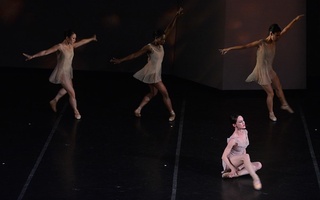There were moments when the audience held its breath, laughed and sighed with delight—and rightfully so. “Next Generation,” the Boston Ballet’s showcase of young choreographers that ran this past weekend, was truly a marvel. Combining modern and classical elements fluidly, it broke the boundaries of contemporary ballet. Sissones and demi grands were deconstructed, built again, and made new.
Helen Pickett’s “Eventide,” for example, was wondrously cosmopolitan. Pickett, one of the three female choreographers, merged classical East Indian music with that of Western composers for her score. The merger directed the movement. Dancers displayed quick, sharp footwork, but then surprised with slower, sensuous pair interactions. The piece culminated in a kinetic explosion. Set against the backdrop of an abstract expressionist painting, the corps and the principal dancers responded almost instinctively to musical cues. They splattered and dripped with the flick of Pickett’s brush.
Sabrina Matthews’ choreography was also intensely aware of the creative process. Her piece, entitled “Ein von Viel”—which translates to “one of many”—was a male duet set to selections from J.S. Bach’s “The Goldberg Variations.” The use of an onstage pianist, Freda Locker, was successful; the dancers incorporated but never overshadowed her playing. During brief moments of silence, they would subtly communicate with a nod of the head or a shared sense of timing.
The dancers were the stars. John Lam and James Whiteside leaped in stunning muscularity. Every part of the choreography was performed emphatically. In the middle of the piece, the two men unassumingly walked toward the piano. At that moment the simplicity of their white garments, the lighting, and the absence of a set contrasted with the difficulty of the dancers’ feats, underscoring the convergence of the secular and sublime in ballet.
Not as stunning was Heather Myers’ piece “Gone Again.” Though her performance in “Romeo & Juliet” leaves no question as to her ability, her first attempt at choreography was just that—a first. “Gone Again” was an elegant, well-performed piece that complimented the music of Franz Schubert, but it failed to take risks.
Jorma Elo’s “In On Blue,” on the other hand, was remarkable. Even on a titular level, it challenged the audience. The music was by Bernard Hermann, a composer who created numerous scores for Alfred Hitchcock films, and the lighting and costumes were overwhelmingly blue. The dancers jerked their arms and legs robotically. One ballerina even twitched perceptibly as she was laid on the stage floor.
The staccato effect was odd and disorienting. It contributed to a certain Entstellung—a distortion of classical movement. Yet Elo concluded with a series of lifts that were all the more stunning because of the disjointed dance that preceded it. Suddenly the classical vocabulary had new nuance, because it had been broken down and pieced together again. The finale was the center piece of the show. It achieved what “Next Generation” intended to do—to make the classic new.
“I believe that art is a window into the future,” artistic director Mikko Ninssinen declares. If what Nissinen says is true, then the Boston Ballet’s “Next Generation” is flinging open the glass and letting in the fresh air.
Read more in Arts
Snow AngelsRecommended Articles
-
'Quixote' a Fluffy RompBoston Ballet’s revival of “Don Quixote” is a fluffy, lighthearted romp that forgoes a sense of plot in favor of
-
'Viewpointe' Provides New Perspective on DanceFrom the classic works of Balanchine to modern pieces choreographed by students, “Dancers’ Viewpointe VII” brought a high level of
-
ARTSMONDAY: Fresh Take On Ballet In ‘New Visions’The Boston Ballet’s new show delivered what its title deftly suggested: “new visions” for the ambitions of modern ballet. Most
-
 José Mateo Ballet’s “Assault on the Senses” Blends Vigor With Grace
José Mateo Ballet’s “Assault on the Senses” Blends Vigor With Grace -
 Les Ballets Jazz Montréal Loses Sight of Its Powerful Purpose
Les Ballets Jazz Montréal Loses Sight of Its Powerful Purpose













